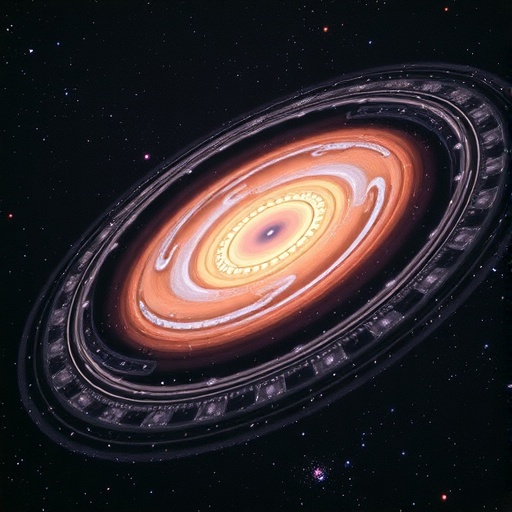New research has reignited interest in one of the most perplexing enigmas of the cosmos: the mysterious gamma-ray excess emanating from the center of the Milky Way galaxy. This shining glow has puzzled astrophysicists for years, prompting debates about its origins and the forces at play in our galactic nucleus. Recent advancements in theoretical and computational astrophysics may have shed light on this issue, suggesting that dark matter could once again take center stage in explaining this captivating phenomenon.
The study, spearheaded by Dr. Moorits Muru and his colleagues at the Leibniz Institute for Astrophysics Potsdam, presents a groundbreaking perspective on the problem. Collaborating with notable scientists like Professor Yehuda Hoffman from the Hebrew University of Jerusalem and Professor Joseph Silk from Oxford University, the research team employed advanced cosmological simulations to delve into the early history of the Milky Way. Their findings suggest that the distribution of dark matter in the galaxy’s core may be far more complex than previously envisioned, leaning toward a non-spherical shape that could account for the detected radiation from this region.
Historically, the excess gamma rays, referred to as the Galactic Center Excess, prompted numerous hypotheses. Early theories speculated that these high-energy emissions were the result of dark matter particles colliding and annihilating one another. However, as observational data accumulated, the spatial distribution of the gamma rays did not align with the predicted distributions of dark matter. This led many in the scientific community to pivot toward alternative explanations, particularly centered on a specific type of cosmic object: millisecond pulsars. These rapidly rotating neutron stars produce significant radiation and could potentially explain the gamma-ray output.
In their research, Muru and his colleagues devised a novel approach, utilizing a suite of high-resolution simulations known as Hestia. These simulations allowed them to reconstruct the evolutionary history of the Milky Way, taking into consideration the galaxy’s tumultuous early formation characterized by numerous violent mergers. The use of Hestia provided a unique lens through which to view dark matter’s role in shaping the structure of the galaxy and elucidating the sources of gamma rays emerging from the center.
The team’s calculations have unveiled a more intricate framework for the distribution of dark matter at the galaxy’s nucleus, differing dramatically from earlier, simplistic models. Their results point towards a nonspherical arrangement of dark matter, which potentially aligns with the observed gamma-ray emissions without requiring the extensive population of millisecond pulsars that other theories have proposed. This is a significant shift in understanding, as it opens the door to new interpretations of the signals we observe in the cosmos.
The researchers contend that the Milky Way’s extensive history of collisions and growth is instrumental in shaping the core’s dark matter characteristics, leaving unique markers for scientists to decode. This revelation is pivotal, as it implies that the gamma-ray signals, long thought to be enigmatic, might indeed hold the fingerprints of dark matter interactions, reinforcing its status as a vital player in cosmological phenomena.
While the findings from Muru’s study do not conclusively resolve the debate surrounding the Galactic Center Excess, they effectively rejuvenate dark matter’s reputation as a credible explanation for these celestial emissions. Further observational efforts, particularly with instruments like the Cherenkov Telescope Array, are on the horizon and promise to deliver new data that could decisively differentiate between competing theories. This next phase of research holds the potential to either substantiate the presence of dark matter or unveil new narratives altogether about our galaxy.
In light of these developments, the astronomical community is filled with anticipation. The potential confirmation of dark matter’s observable impacts would be groundbreaking, lending credence to long-held theories while simultaneously pushing the boundaries of our understanding. If proven correct, these findings might offer profound insights into the nature of our universe and the elusive constituents that govern it.
As we aim to unravel the secrets of the universe, studies like this serve as crucial stepping stones. They exemplify the symbiosis of computational modeling and empirical observation, a collaboration that is fundamental to advancing our knowledge of astrophysics. The meticulous work by Muru and his team not only enhances our understanding of dark matter but also inspires future investigations that will undoubtedly shape the future of astrophysics research.
The excitement surrounding these findings is palpable, as researchers and enthusiasts alike contemplate the implications of a renewed focus on dark matter. The path forward remains fraught with questions, yet the study provides a fresh lens through which to scrutinize one of the most fascinating signals in our galaxy. Ultimately, whether we validate dark matter’s role or uncover entirely new elements of the Milky Way, the pursuit of these answers reflects our relentless desire to grasp the complexities of our universe.
As we await further explorations and revelations from the cosmos, the scientific community stands united in its commitment to pursuing the truth. The intricate dance between dark matter and gamma rays is far from over, and we find ourselves on the precipice of discovery, ready to decipher the universe’s complex mysteries.
Subject of Research:
Article Title: “Fermi-LAT Galactic Center Excess morphology of dark matter in simulations of the Milky Way galaxy”
News Publication Date: 16-Oct-2025
Web References:
References:
Image Credits:




